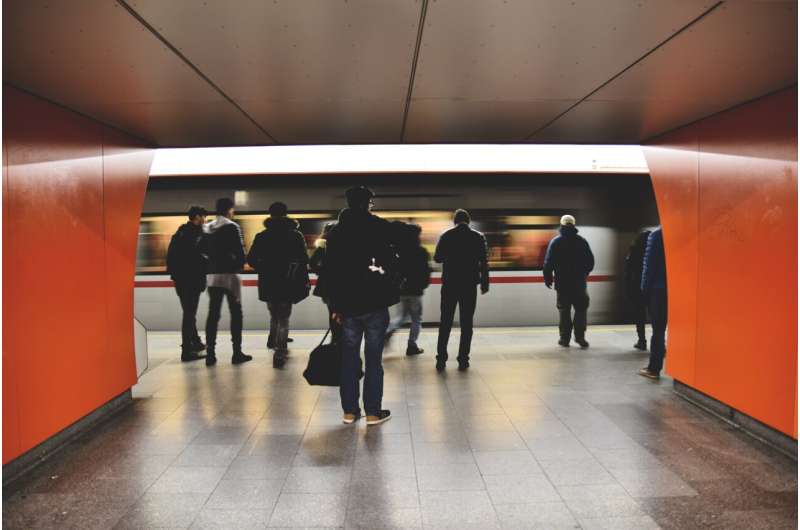This article has been reviewed according to Science X's editorial process and policies. Editors have highlighted the following attributes while ensuring the content's credibility:
fact-checked
trusted source
proofread
Subway stations near river tunnels have worst air quality

Subway riders waiting in stations near tunnels that run below the city's rivers are exposed to higher levels of hazardous pollutants than are found in other stations. The "river-tunnel effect," as researchers call it, may help explain extremely poor air quality in the nation's largest underground transit system and have particular implications for stations close to rivers in general.
In a previous investigation of New York's subways, researchers at NYU Grossman School of Medicine found considerable variation in air quality among city subway stations. While some had pollutant levels a few times higher than that of outdoor air, the air quality in others was comparable to sooty air contaminated by forest fires or building demolitions.
To better understand why, the NYU Grossman research team measured air quality samples in 54 NYC stations during morning rush hour. They found that stations neighboring river tunnels had 80% to 130% higher concentrations of potentially dangerous particles in the air compared with stations only two or three stops further away from rivers. The new study published online Dec. 30 in the journal Transportation Research Part D: Transport and Environment.
"Our findings help explain why some underground subway stations are more polluted than others," says study lead author David Luglio, MS; a doctoral student at NYU Grossman School of Medicine. "Those subway stations closest to rivers clearly must be prioritized during cleaning efforts."
To explain the "river-tunnel effect," Luglio notes that while many tunnels in the city's underground subway system have some degree of air exchange with the surface, those traveling beneath water have more limited ventilation. As a result, harmful debris gets trapped and builds up over time. Trains passing through may then throw these iron and carbon particles back into the air and push them into the closest stations—those at either end of the tunnel.
The investigation, which Luglio says is the largest exploration to date of how river tunnels influence air quality in underground subway stations, also revealed that proximity to a river tunnel was the strongest factor in predicting a station's pollution levels, followed by its age. Other potential contributors, such as station size and depth, did not appear to play a major role in air quality differences.
The Metropolitan Transit Authority reported that 5.5 million people rode New York City's subways every day in 2019, before the COVID-19 pandemic began. According to past research, passengers were exposed to air with high levels of particles, which experts have linked to lung and heart disease as well as overall higher risk of death.
For the investigation, researchers collected over 100 air samples in stations between February and March 2022. Among the results, the study showed that on average, pollutant levels in all measured stations exceeded the daily exposure limit advised by the Environmental Protection Agency, which assesses potential health hazards in the environment.
For comparison, and to confirm the river-tunnel effect, the study team measured particle buildup on the B-line, a train route that crosses the East River via a bridge instead of passing beneath the water. Notably, pollutant levels in the two stations closest to the river on this train route were lower than that of stations farther away—as expected, the reverse of the river-tunnel phenomenon.
"Now that our results have identified key contributors to poor air quality in New York City's underground subway stations, we have a better idea of where to improve conditions in the most contaminated areas of the transit system," says study senior author Terry Gordon, Ph.D. "Increasing ventilation and scrubbing the tunnel walls and floors to remove continually recycling debris may make stations safer for riders and transit workers," adds Gordon, a professor in the Department of Medicine at NYU Langone Health.
Gordon, also a member of NYU Langone's Center for the Investigation of Environmental Hazards, cautions that since the investigation only explored subways in New York City, it remains unclear whether the river-tunnel effect occurs in other cities as well.
He adds that the study team next plans to examine the effects of subway contaminants on human cells to better pinpoint the level of exposure needed to pose a risk to human health.
In addition to Luglio and Gordon, other NYU Langone study investigators involved in the study were Tri Huynh, BS; and Antonio Saporito, BS.
More information: David G. Luglio et al, Investigation of a river-tunnel effect on PM2.5 concentrations in New York City subway stations, Transportation Research Part D: Transport and Environment (2022). DOI: 10.1016/j.trd.2022.103579
Provided by NYU Langone Health




















